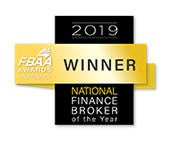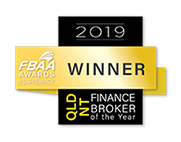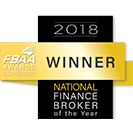“My first experience with the Barefoot Investor was with my sister. We were going for a coffee, and she whipped out an orange ING bank card with “SPLURGE” written in Sharpie right across the front.
She noticed my puzzled glance and proceeded to explain all about her special bank account setup.
Mojo, Fire Extinguisher, Grow…
Initially, I thought she was talking about an Austin Powers movie, but all this has to do with different bank accounts, buckets and budgeting. And it all comes from a book written by an Aussie financial expert called “The barefoot investor”.

Today I am going to walk you through the Barefoot Investor Bank Accounts and Bucket strategy. I will take you through each of the different account names and types and how to set everything up.
So if you’ve read the book, got partly through it, then given up, and are now left with thousands of different bank accounts open, this article is for you.
Let’s jump right in.
Table of Contents
Barefoot Investor Basics
At its core, the Barefoot Investor is a new-age way of saving money by using multiple bank accounts and automated transfers to move your money into different ‘buckets’ based on your financial goals. It is designed to help you manage your money better by providing you with the tools to save, budget and invest with ease,
It’s a much smarter method of saving. Strict budgeting and tracking expenses on a spreadsheet only work for a very small number of people.
By automating your finances, you take willpower out of the equation. That means you can focus on what really matters: getting rid of your debts, buying your family a home, and setting yourself up for a wealthy retirement.
But when I told my friend that I was going to be writing an article on the Barefoot Investor, she just said:
“Ugh, I gave up; too many buckets, too many bank accounts”, which got me thinking.
Is this a common occurrence for those who’ve read the book?
If you feel a bit overwhelmed by all the different buckets and bank accounts, keep reading. I will break down each bucket and bank account you need and how to use them.

Your Money Mindset [How to Increase Your Savings ASAP]
Before we dig into the details about the buckets and bank accounts, let’s quickly talk about your money mindset – how you think about money and your financial priorities.
Your money mindset is a set of beliefs and attitudes you have about money, wealth and success, which determine how you handle money. One of the key ways of achieving financial success is by building a positive money mindset…
Why is this important?
A positive mindset is important because, regardless of how simple the Barefoot Investor system is, it still requires work. You aren’t going to pay down all your debts, buy a home and retire wealthy with a brief period of effort. It’s going to take years of commitment to achieve your financial goals.
There are going to be hard times when you’ll be tempted to throw it all away and go back to the old way of doing things. So you need to have a good reason why you’re doing this.
Identify (and master) your invisible scripts about money
There’s an old joke: Two fish are swimming in a pond when an older fish starts swimming the other way towards them. When the older fish passes them, he nods and says, “Good morning! How’s the water?” The two fish swim for a while before one of them looks to the other and asks, “What the hell is water?”
Those poor younger fish have been trapped by Invisible scripts.
Invisible scripts are truths so ubiquitous and deeply embedded in society that we don’t even realise they guide our attitudes and behaviour. These beliefs have been passed down from generation to generation. They usually go unquestioned, yet they shape our attitudes and behaviours around money. Like water to a fish, they surround us even if we don’t know it.

Everyone has invisible scripts about money
These are the things you have internalised about money. You might not realise you have them, yet they shape how you treat your money.
Invisible scripts are a topic that doesn’t get discussed often. It is mostly because invisible scripts are revealing, and the things they reveal might be tough pills to swallow.
But the good news is that they only control you when they are invisible. Once you bring them to light, you can take back control and make decisions about your money that suit YOUR best interests.
Do any of the following invisible scripts below resonate with you?
Invisible script #1: “I’m just not good with money.”
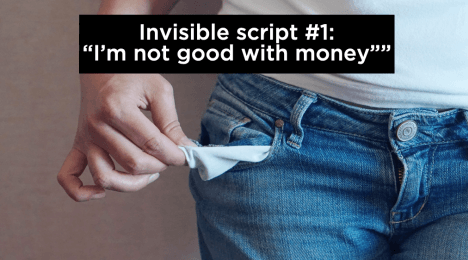
This is a really common invisible script, and it’s a problem because it’s so self-defeating. If you don’t think you’re good with money, the game is over before it even begins.
Usually, when someone says, “I am not good with money”, they mean they have difficulty managing their finances, struggle to make sound financial decisions, overspend regularly, don’t save enough or don’t understand basic financial concepts.
The good news is: No one is born ‘good with money.’
It’s a learned skill. And it’s a skill you can learn.
Being good with money has more to do with your behaviour than your brains. You don’t need to be an expert to win at money.
It’s much more important to start than it is to be smart.
Invisible script #2: “I don’t earn enough money to save.”
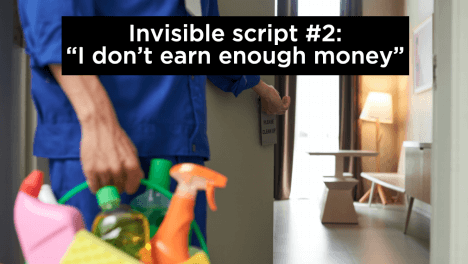
Most people want to start saving when they ‘earn enough’. The truth is you will never have ‘enough’. If you are undisciplined, the more you earn, the more you spend. Having control of your financial future has nothing to do with how much money you earn.
There are people in Australia on multiple six-figure incomes who are completely out of control regarding their money. In fact, some of the “richest” looking people are the ones who are struggling the most with debt and financial security.
On the other hand, there are others that have never earned more than minimum wage for their entire lives but have used smart saving strategies and the power of compound interest to buy their own homes and retire with a multi-million dollar investment portfolio.
It’s not about what you earn but what you save.
Invisible script #3: “It’s too late for me.”
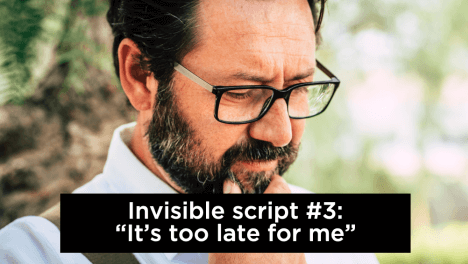
Many people think it’s too late to start saving because they feel they’ve made too many bad financial decisions over the years. This can be especially true when it comes to retirement savings, which often require years of consistent saving to build up a nest egg. The good news is that it’s never too late to start saving. Even if you’re behind, you can still make progress towards your goals.
It doesn’t matter how old you are – whether you’re just starting out or you’re approaching retirement, there’s no point beating yourself up about money mistakes you made when you were younger.
The best time to plant a tree was 20 years ago. The second best time to plant a tree is today.
The average life expectancy in Australia is 82 years. How old are you now? Subtract your current age from this number.
Now you have a rough idea of how many years you have left on this planet. What are you going to do with them? Will you continue to stress about money and feel out of control of your own life?
Or will you step up and take action?
Invisible script #4: “The economy sucks.”
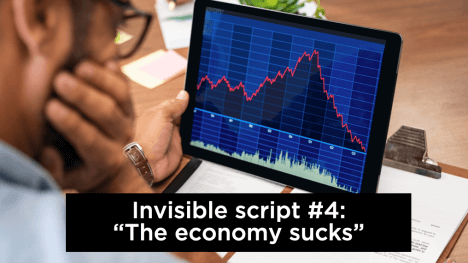
I get it – things are pretty tough right now. Our generation has already lived through the GFC – and now the coronavirus pandemic means that we’re going to have a rough time economically for the next few years. Add rising inflation and interest rates into the mix, and you can understand why we are the generation that seems to be having it the worst of all.
However, you can’t let that be an excuse. The economy is always going to have its ebbs and flows. But the economy also always recovers…
And the reality is – it doesn’t matter what the economy is doing. You’ll still be better off financially if you follow a smart saving system – whether in good times or bad.
More millionaires were created in the Great Depression than at any other time. And the ones who became millionaires back then weren’t the people who gave up because the economy was in the toilet – they were the people who stuck to their guns and did the work.
You can make progress, or you can make excuses.
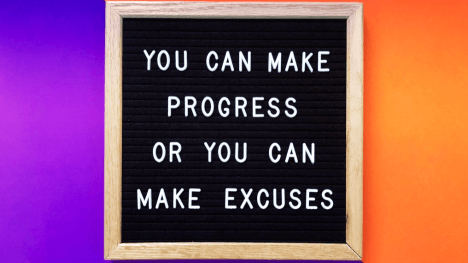
There are plenty of other invisible scripts you might have about your money, and it’s worth spending some time thinking about your invisible scripts so you can address them.
But no matter your situation, no matter what your invisible scripts are:
- Excuses aren’t going to save you when you get hit with a financial emergency.
- Excuses aren’t going to change your bank balance.
- Excuses aren’t going to set you up for retirement and keep you financially secure through life’s inevitable ups and downs.
The thing that is going to bring control over your money and your life is taking action.
It’s hard to admit that you’re not as financially successful or sorted as you tell yourself you are. But once you commit to making daily progress, you’re already free.
Financial freedom isn’t about your bank balance or what house or car you have. It’s a mindset – knowing that you’re taking action to care for yourself and your loved ones. Financial freedom is having control of your finances, no matter how little you earn. It is about working towards having enough to cover your expenses, pay off debt, save for the future and have some left over to enjoy life…
What are your top priorities with money?
Money in itself has no value. The value in money comes from the things it helps you achieve.
All the money in the world won’t make you happy. It’s what you do with your money that makes you happy.

I’m going to share my top 3 priorities with you. Yours might differ from mine, but whatever they are, you should be clear about what having money will do for you.
Here are my top three priorities:
- Financial security: I don’t want to stress about money. If the worst-case scenario happens, I want to know that I’ve got it covered.
- Freedom to travel and spend time with family and friends: For me, life is about the journey. It’s not about a hard, joyless slog through life trying to preserve every penny along the way. It’s the experiences and good times you have along the way with friends and family that make life worth living.
- Build long-term wealth to retire comfortably: We’re all going to get old eventually. And when it comes time to retire, I want to be comfortable. Retirement is supposed to be your golden years – a reward for your hard work over your life. Stressing out about money isn’t part of my retirement plan.
Spend some time thinking about your own money priorities. It will make the hard times easier and make you much more likely to succeed.
Now that’s out of the way, let’s dive into the nitty-gritty details. In the rest of this post, I will explain the whole Barefoot Investor system to you.
Barefoot Investor Buckets
In this section, I’m going to break down the bank accounts and simplify them, so you don’t end up like my friend – who gave up.
The Barefoot Investor recommends splitting your income into three separate groups called “buckets.”
- Blow Bucket: This is the money you will spend in the short term. The money here is used for daily expenses, the occasional splurge, holidays, and some extra cash to fight financial fires.
- Mojo Bucket: The mojo bucket is used for your rainy-day emergency savings. It’s safety money for any financial emergencies that crop up.
- Grow Bucket: This is your money-maker bucket. The grow bucket is where you do your investing and look for longer-term wealth building.

In summary, one bucket is for spending money on life, one is for savings for a rainy day/emergency, and the other is for long-term investments.
Blow Bucket
Now that we’ve moved from our three main categories and demystified the use of these funny words, it’s time to break down what the BLOW bucket means.
This is the one that causes all the confusion, and for my friend, it is the straw that broke the camel’s back.
Your Blow bucket is for expenses and splurge money. A lot of Aussies have just this one bucket and nothing else, and it’s one of the reasons why many people find it hard to save.
When you use one account for everything, the money just tends to evaporate. You might have some general ideas about saving and investing, but when it’s all in one place, it’s easier for it to disappear.
This is where the following funny-named bank accounts come in.
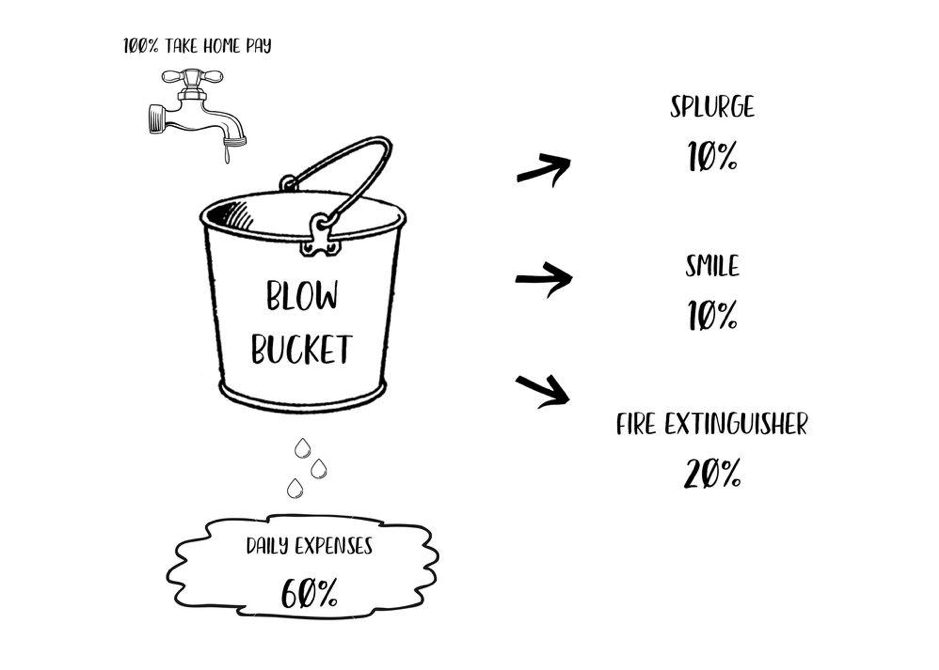
- Daily Expenses: For your day-to-day living expenses such as food, housing costs, utilities, and fuel.
- Splurge: Guilt-free spending money for small things like a new pair of shoes or a round of beers for your mates.
- Smile: More guilt-free spending money, but this time for larger purchases that will put a smile on your face, like a holiday, a new couch, or a car.
- Fire Extinguisher: As the name suggests, this account is for fighting “financial fires”, like paying down debt, saving a deposit, or paying off your mortgage.
In summary, under the blow category, the next step is to set up four bank accounts. You can do this through ING.
Let’s take a look at each account in more detail.
Daily Expenses – Your everyday spending you need to live off (60% income)
All of your income should go into your Daily Expenses account. Aside from being the main account, you’ll use for your Blow bucket, the Daily Expenses account is like the routing centre for the rest of your accounts.
You will leave 60% of your income in this account for your Daily expenses and then send the rest to your other accounts.
You should aim to limit your daily expenses to 60%of your take-home pay.
We can break this down further:
- 30% maximum on housing (rent or home loan)
- 5-10% on utilities
- 5-10% on transport
- 5% on insurance
- 5-10% on food
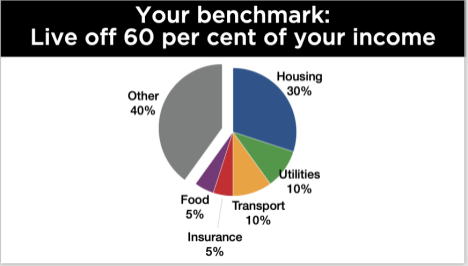
This 60% is a guideline – those with lower or higher incomes might have slightly different figures. But in most cases, you should be able to keep your daily expenses within this limit. If not, it might be time to re-evaluate your spending and see what you can cut down on.

Splurge – Spending on things you love (10% income)
Now that we’ve covered your daily expenses, it’s time to break down the other 40% of your income. We’ll start with the fun one – your splurge account.
Set up an automatic transfer of 10% of your take-home pay from your Daily Expenses account into your Splurge account. Your Splurge account will have its own ATM card. Keep it at the front of your wallet and mark it SPLURGE with a Sharpie.
This is your guilt-free spending money. Go out and blow this money on whatever you want – a new pair of shoes, a round of beers for your mates, whatever you like.
The only rule for this money is: when it’s gone, it’s gone. You can’t cut into your other accounts for your splurge money.

Smile – long term savings for fun things (10% income)
Another 10% of your take-home pay should be automatically transferred from Daily Expenses to your Smile account (online saver).
This isn’t linked to a bank card.
This account is for bigger goals like holidays, weddings, and other fun things that will cost more than a few weeks’ wages.
This 10% isn’t set in stone – if you are saving up for something bigger like a wedding or a big overseas trip, do the numbers and see how much you will need to put into your Smile account to make it happen.

But if it’s more than 10% of your take-home pay, then you will need to adjust your living expenses accordingly.
Fire extinguisher – debt and financial stress reduction (20% income)
And finally, we have the fourth account, which is a fire extinguisher.
This account is also not linked to a bank card.
You will use your Fire Extinguisher account to put out any financial fires you have, such as credit card debts, saving for a home deposit or paying off your mortgage.
You will use this at different stages in your life for different things, but the 20% should stay the same.
What should you do with it now? That depends:
- Do you have any debt (other than a mortgage)? Then allocate the 20% to paying down your debts until they’re gone.
- Debt-free? Put that money towards saving a deposit for your home.
- Already got a home? Use the money to pay off your mortgage.

Setting up your four core Barefoot Investor Bank Accounts
In theory, you could set up these four core bank accounts with any bank. But in the Barefoot Investor, Scott Pape recommends that you set up these accounts with ING.
Why?
Because they don’t charge bank fees. You might not think that bank fees are a big deal, but it really adds up. The average Australian pays $489 in bank fees each year. Over the course of your life, that could easily add up to $20,000 or more. That money is better off in your pocket than some shady bank executive’s, so it makes sense to find a bank with no fees.
This brings us to your new best friend – the ING Orange Everyday debit card. ING has no fees and will even refund your ATM fees as long as you put in $1,000 per month (usually covered by your salary) and make at least 5 transactions with your card.
You can set up your accounts online, and ING often offers recommendation codes that will give you a bonus for signing up. Jump online, search for “ING referral code”, and put in the code to set up your account.
Otherwise, if you don’t have a referral code, you can simply go online and set up an account following the prompts here.
You will need to set up four accounts. Two of your accounts will be Everyday bank accounts. Call one “Daily expenses” and the other “Splurge”.The other two bank accounts will be Online Saver accounts. Call those “Smile” and “Fire Extinguisher”.
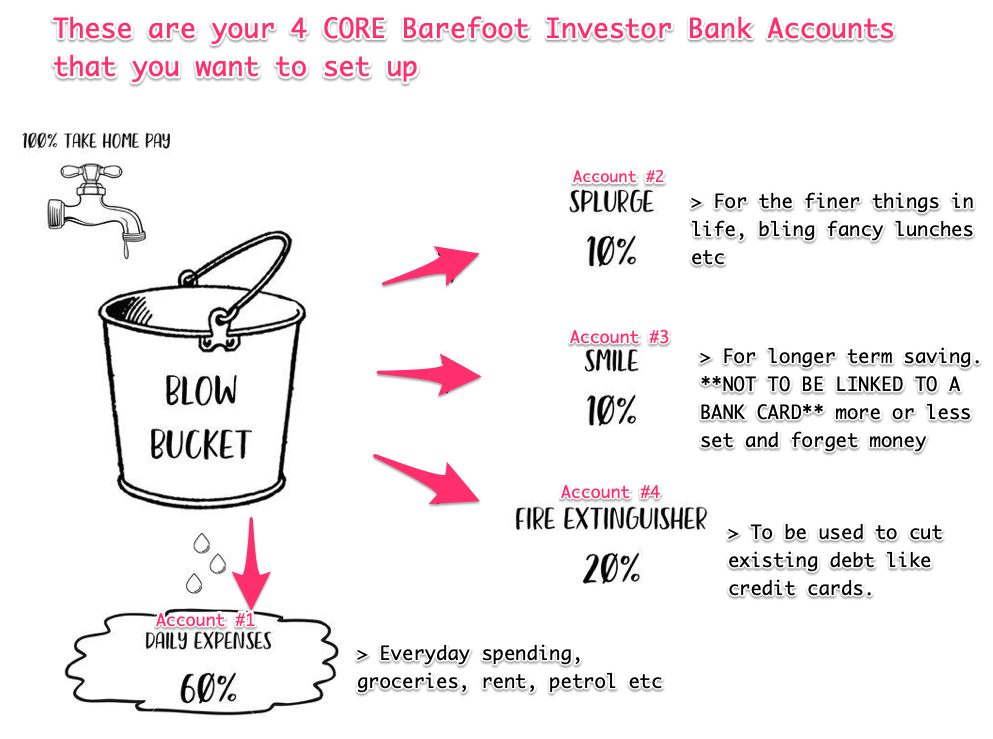
Setting up your automated saving system
Once your bank accounts are all set up, the next step is to set up your automated payments.
First, contact your employer and tell them to put 100% of your take-home pay into your “Daily Expenses” account. Do it in writing.
Once that’s done, the rest is fairly straightforward.
Set up a recurring transfer from your Daily Expenses account into your other accounts every pay cycle. Here’s how to do it:
- Splurge: 10% of your take-home pay.
- Smile: 10% of your take-home pay.
- Fire Extinguisher: 20% of your take-home pay.
Once that’s done, you’ve set up the most important part of the Barefoot Investor system.
You now have one account for your daily expenses, another account for guilt-free short-term spending, one for larger purchases that make you happy, and another for fixing your financial fires.
Mojo Bucket
So now that you’ve got your core accounts set up, it’s time to step away and open a separate account. This one is called Mojo.
This is your emergency money. You only use it for real emergencies like losing your job or getting sick. And no, a really good deal on a holiday getaway is not an emergency.
Having this money on hand for emergencies will change how you think about money. Once you know you’re covered in case of an emergency, a great weight will be lifted from your back.

Mojo is recommended to be with a different bank.
You should set up this account at a completely different financial institution from your other accounts. You do this because you want to put this money out of sight and make it hard to get to it. That way, you won’t be tempted to dip into this money unless you really need it.
You can choose any online bank with no fees for this account. Scott Pape recommends UBank USaver, but you can stick with your existing account as long as they don’t charge you any fees.
When it comes to Mojo, you need to start by gathering as much money as you can to save at least $2,000 to get you kickstarted into gear.
Whether it’s selling clothes, old iPhones or whatever you can find. It’s about gathering the money to get your Mojo account up and running.
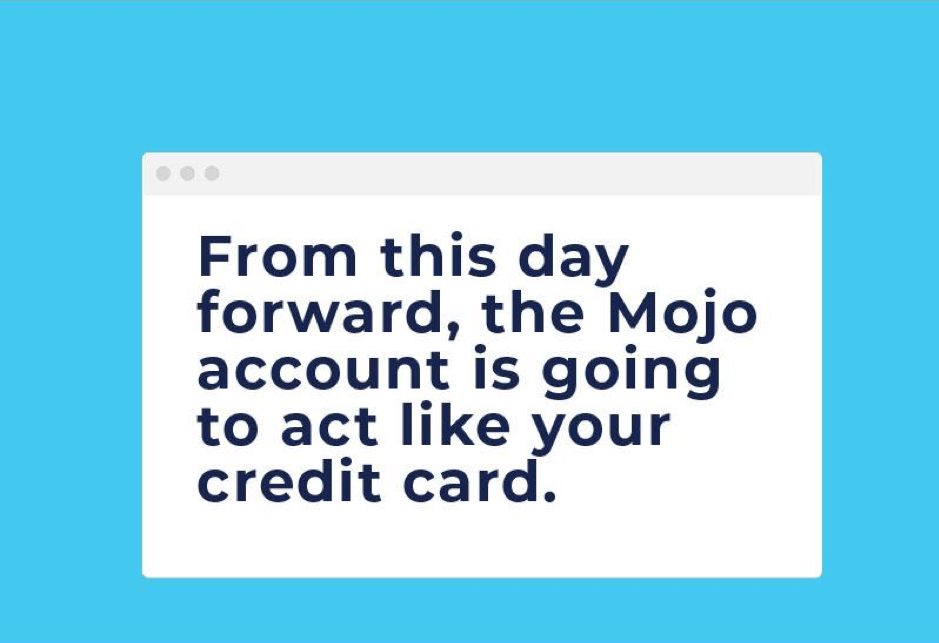
Once you have the initial $2,000 in this bucket, you won’t be adding to this account in the short term. It will come back into play once you’ve paid off your debts, saved a deposit, and bought a home.
After you’ve done all that, you will use your Fire Extinguisher money to build up a minimum of three months’ living expenses. Read the book for more details about this part of your financial journey.
From this day forward, the Mojo account will act like your credit card.
After that, you continue building your Mojo, which will then move into your Grow Bucket.

Grow Bucket
The third and final bucket – the grow bucket – is for building long-term wealth. The aim of this bucket is to get a little wealthier every day.
Thanks to the wonders of compound growth, every dollar you put into this bucket should double every 7 to 10 years or so. That might not sound like much, but over the course of your life, it can make you incredibly wealthy.
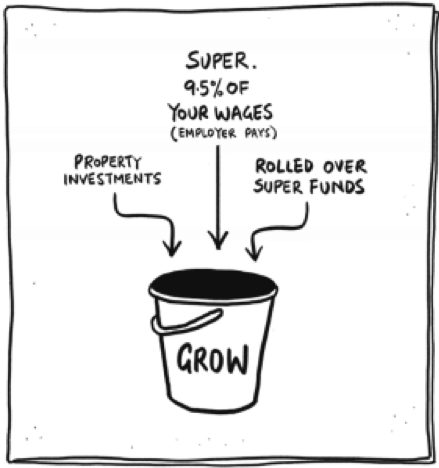
This bucket includes your super fund and any other investments you own. For now, it might just be your super, and that’s fine.
Your Grow bucket is outside the scope of this post – we’re focusing here on setting up your accounts. But it’s still a good way to think about your money.
In the Barefoot Investor system, the Grow bucket comes into play once you’ve bought your family home. Once you’ve done that, you will increase your super contribution to 15%.
And once your family home is paid off, you can use your Fire Extinguisher money to start investing. You can invest this money however you like. You can choose to keep it as savings, as shares, property or cryptocurrency.

An example of how the Barefoot Investor accounts work
All of your income goes into the BLOW bucket.
- 60% goes into Daily expenses
- 10% Splurge
- 10% Smile
- 20% fire extinguisher
Then from the Fire Extinguisher, you pay off debt.
- You will use your Daily Expenses account to keep the lights on, the car running, and food in your belly.
- Your Splurge account goes towards guilt-free spending on whatever you want – a nice dinner with the wife or a new X Box. Spend it on whatever you want – but when it’s gone, it’s gone.
- You use the Smile account to cover larger expenses like holidays, weddings, and big purchases.
- And finally, the Fire Extinguisher account is used to fight your financial fires. It starts with paying off all of your debt. Next, you use it to save a deposit and buy a home. Then, you use it to pay off your home as quickly as possible. Once you’ve done all that, you will use your Fire Extinguisher to build wealth in your Grow bucket.
It’s a simple system, but that’s why it’s good. It’s flexible enough that you can use it throughout your life no matter how much (or how little) you make. But it still enforces good savings habits and will put you on the path to long-term wealth.
How to set up the Barefoot Investor accounts?
ING gives out recommendation codes to get $75 when you sign up.
Jump online and put in the code, and you’ll be able to set up your account. Otherwise, if you don’t have a referral code, you can simply go online and set up an account following the prompts here.
Once you’ve set up your bank account, then your two cards will be mailed out to you.
As it’s an online bank, it’s really easy to do from the comfort of your own home.
They also have good customer service if you call them.
Bonus: some important money habits
As I have mentioned in this article, managing your money well is the best way to get financial freedom.
Here are some quick money habits you can pick up:
- Live below your means. Simply put, this means you must spend less money than you make. But this does not mean you can’t spend money on things you enjoy. It just means being prudent about it.
- Close down any unnecessary credit cards. Credit cards tempt you to buy things you can’t afford and may also negatively affect your credit rating.
- Set good money (and life) goals. But don’t overwhelm yourself with too many goals. Start with one goal, e.g. I want to save $2,000 in my emergency fund. Once you have achieved that goal, move on to the next one.
- Regularly review your progress to see if you are on the right track. Sometimes your goal may seem to be taking too long, which can be discouraging. But regularly reviewing your progress will reassure you that you are making steps in the right direction.
- Find ways to make a little extra income on the side. You can freelance after work or get small jobs on the weekends. But don’t also forget to set aside time to rest and relax.
- Budget for big expenses like weddings, holidays etc. Weddings and holidays don’t just happen suddenly. They usually take a few months to plan, giving you enough time to save for all the associated expenses.
- Automate bill payments whenever possible. Automating bill payments is the best way to ensure that you don’t miss any payments, and this can save you money in penalties and prevent you from negatively affecting your credit score.
- Create a budget and stick to it. Track your income and expenses to ensure you live within your means.
- Pay off debt as quickly as possible. Paying off debt is one of the best ways to increase financial security. It helps you maintain a good credit score, but even better, it helps you save by reducing the interest you pay on your debts.
Next steps and getting your home loan.
Have you saved money for a house deposit but don’t know where to start in buying a home?
Our team at Hunter Galloway is here to help you buy a home in Australia. Unlike other mortgage brokers who are just one-person operations, we have an entire team of experts dedicated to helping make your home loan journey as simple as possible.
If you want to get started, please give us a call on 1300 088 065 or book a free assessment online to see how we can help.







 Start again
Start again








